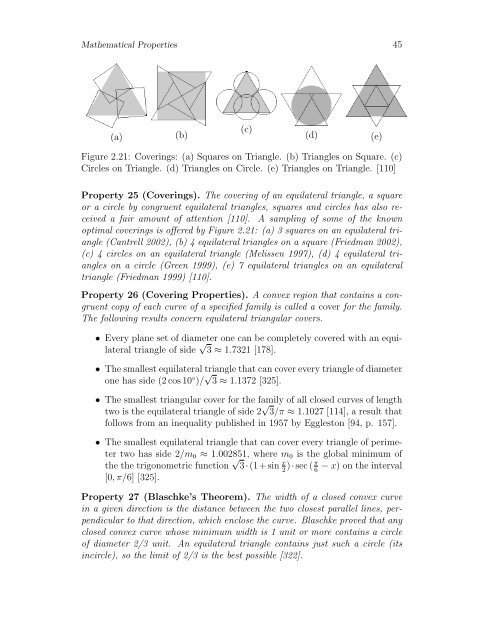MYSTERIES OF THE EQUILATERAL TRIANGLE - HIKARI Ltd
MYSTERIES OF THE EQUILATERAL TRIANGLE - HIKARI Ltd
MYSTERIES OF THE EQUILATERAL TRIANGLE - HIKARI Ltd
You also want an ePaper? Increase the reach of your titles
YUMPU automatically turns print PDFs into web optimized ePapers that Google loves.
Mathematical Properties 45<br />
(a)<br />
(b)<br />
(c)<br />
(d) (e)<br />
Figure 2.21: Coverings: (a) Squares on Triangle. (b) Triangles on Square. (c)<br />
Circles on Triangle. (d) Triangles on Circle. (e) Triangles on Triangle. [110]<br />
Property 25 (Coverings). The covering of an equilateral triangle, a square<br />
or a circle by congruent equilateral triangles, squares and circles has also received<br />
a fair amount of attention [110]. A sampling of some of the known<br />
optimal coverings is offered by Figure 2.21: (a) 3 squares on an equilateral triangle<br />
(Cantrell 2002), (b) 4 equilateral triangles on a square (Friedman 2002),<br />
(c) 4 circles on an equilateral triangle (Melissen 1997), (d) 4 equilateral triangles<br />
on a circle (Green 1999), (e) 7 equilateral triangles on an equilateral<br />
triangle (Friedman 1999) [110].<br />
Property 26 (Covering Properties). A convex region that contains a congruent<br />
copy of each curve of a specified family is called a cover for the family.<br />
The following results concern equilateral triangular covers.<br />
• Every plane set of diameter one can be completely covered with an equilateral<br />
triangle of side √ 3 ≈ 1.7321 [178].<br />
• The smallest equilateral triangle that can cover every triangle of diameter<br />
one has side (2 cos 10 ◦ )/ √ 3 ≈ 1.1372 [325].<br />
• The smallest triangular cover for the family of all closed curves of length<br />
two is the equilateral triangle of side 2 √ 3/π ≈ 1.1027 [114], a result that<br />
follows from an inequality published in 1957 by Eggleston [94, p. 157].<br />
• The smallest equilateral triangle that can cover every triangle of perimeter<br />
two has side 2/m0 ≈ 1.002851, where m0 is the global minimum of<br />
the the trigonometric function √ 3·(1+sin x)·sec<br />
(π − x) on the interval<br />
2 6<br />
[0, π/6] [325].<br />
Property 27 (Blaschke’s Theorem). The width of a closed convex curve<br />
in a given direction is the distance between the two closest parallel lines, perpendicular<br />
to that direction, which enclose the curve. Blaschke proved that any<br />
closed convex curve whose minimum width is 1 unit or more contains a circle<br />
of diameter 2/3 unit. An equilateral triangle contains just such a circle (its<br />
incircle), so the limit of 2/3 is the best possible [322].

















